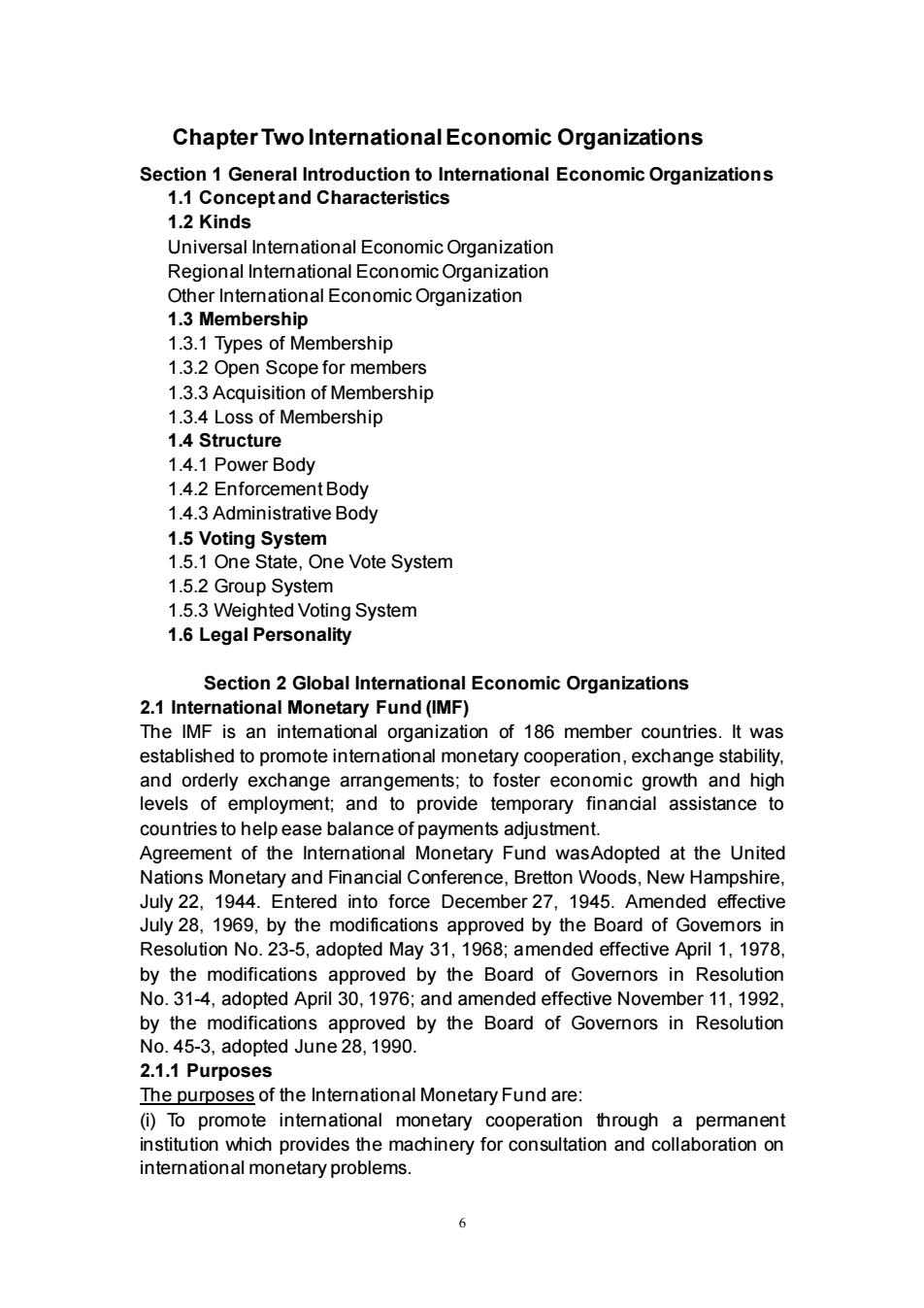正在加载图片...

Chapter Two International Economic Organizations Section 1 General Introduction to International Economic Organizations 1.1 Conceptand Characteristics 1.2 Kinds Universal Intemnational Economic Organization Re Other International Economic Organization 1.3 Membership 1.3.1 Types of Membership 1.3.2 Open Scope for members 1.3.3 Acquisition of Membership 1.3.4 Loss of Membership 1.4 Structure 1.4.1 Power Body 1.4.2 Enforcement Body 1.4.3 Administrative Body 1.5 Votin g System 1.5.1 One State,One Vote System 1.5.2 Group System 1.5.3 Weighted Voting System 1.6 Legal Personality Section 2 Global International Economic Organizations 2.1 International Monetary Fund(IMF) The IMF is an intemational organization of 186 member countries.It was established to promote intemational monetary cooperation,exchange stability. and orderly levels of exchange arrangements:to foster economic growth and high employme and to provide temporary ncal assistance to countries to help ease balance of payments adjustment Agreement of the International Monetary Fund wasAdopted at the United Nations Monetary and Financial Conference,Bretton Woods,New Hampshire, July 22.1944.Entered into force December 27.1945.Amended effective luly 28 1969 by the modifications approved by the Board of Govemors in Resolution No.23-5,adopted May 31.1968;amended effective April 1.1978 by the modifications approved by the Board of Governors in Resolution No.31-4,adopted April 30,1976;and amended effective November 11,1992, by the modifications approved by the Board of Governors in Resolution No.45-3.adopted June 28.1990. 2.1.1 Purposes The purposes of the International Monetary Fund are: (i)To promote intemnational monetary cooperation through a permanent institution which provides the machinery for consultation and collaboration on international monetary problems. 66 Chapter Two International Economic Organizations Section 1 General Introduction to International Economic Organizations 1.1 Concept and Characteristics 1.2 Kinds Universal International Economic Organization Regional International Economic Organization Other International Economic Organization 1.3 Membership 1.3.1 Types of Membership 1.3.2 Open Scope for members 1.3.3 Acquisition of Membership 1.3.4 Loss of Membership 1.4 Structure 1.4.1 Power Body 1.4.2 Enforcement Body 1.4.3 Administrative Body 1.5 Voting System 1.5.1 One State, One Vote System 1.5.2 Group System 1.5.3 Weighted Voting System 1.6 Legal Personality Section 2 Global International Economic Organizations 2.1 International Monetary Fund (IMF) The IMF is an international organization of 186 member countries. It was established to promote international monetary cooperation, exchange stability, and orderly exchange arrangements; to foster economic growth and high levels of employment; and to provide temporary financial assistance to countries to help ease balance of payments adjustment. Agreement of the International Monetary Fund wasAdopted at the United Nations Monetary and Financial Conference, Bretton Woods, New Hampshire, July 22, 1944. Entered into force December 27, 1945. Amended effective July 28, 1969, by the modifications approved by the Board of Governors in Resolution No. 23-5, adopted May 31, 1968; amended effective April 1, 1978, by the modifications approved by the Board of Governors in Resolution No. 31-4, adopted April 30, 1976; and amended effective November 11, 1992, by the modifications approved by the Board of Governors in Resolution No. 45-3, adopted June 28, 1990. 2.1.1 Purposes The purposes of the International Monetary Fund are: (i) To promote international monetary cooperation through a permanent institution which provides the machinery for consultation and collaboration on international monetary problems